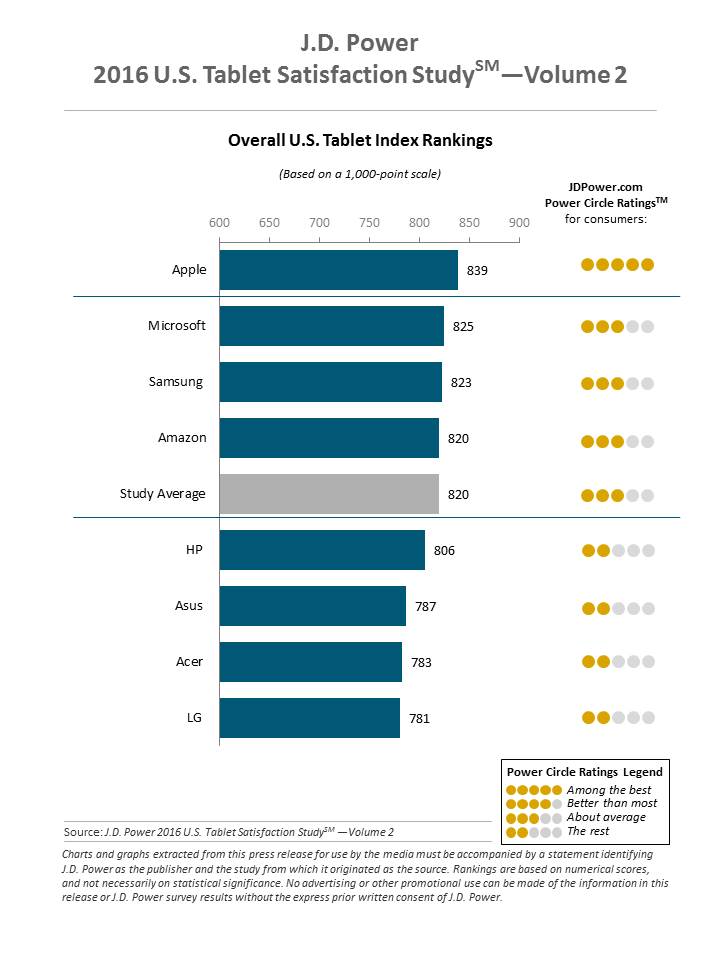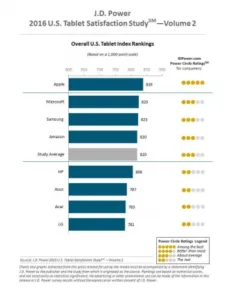US market researcher, J.D. Power has said that tablet buyers are less likely to comparison shop where their current product has a strong brand image. J.D. Power has studied customer satisfaction with tablets across five factors (in order of importance): performance (28%); ease of operation (22%); features (22%); styling & design (17%); and cost (11%) for five years.
According to the study, 56% of customers considered a brand of tablet other than what they ultimately purchased. While overall satisfaction is not significantly different between customers who did and did not consider multiple brands (825 vs. 831, respectively), those who did not consider multiple brands rate their brand higher in most image attributes. Specifically, customers who did not consider multiple brands rate their brand 6.2 (on a 7-point scale) in Bad reputation vs. Good reputation, compared with 6.0 among those who considered multiple brands.
Winning the business of customers who consider multiple brands is particularly beneficial due to their relatively high level of advocacy. On average, these customers made 5.9 positive recommendations about their tablet brand during the previous six months, compared with only 4.7 positive recommendations among those who did not consider multiple tablet brands.
“Winning over customers who consider multiple brands requires appealing to their desire to get a good deal since they are especially price sensitive and tend to pay about $24 less for their tablet than those who do not consider multiple brands,” said Kirk Parsons, senior director and technology, media & telecom practice leader at J.D. Power. “However, brands with a strong lineup of tablet offerings are in a more favourable position to satisfy the needs of consumers interested in upgrading their existing tablet. Brands minimise the need to shop around when customers have a satisfying device experience, thereby leading to increased brand loyalty, recommendations and repurchase intent.”
More than one-third (37%) of customers who consider multiple brands are 18-34 years old, while that age group accounts for only 20% of those who do not consider multiple brands. Customers who consider multiple brands also are more interested in new technology: 26% “strongly agree” that they enjoy reading about new technology vs. 16% who say the same but do not consider other brands.
Study Rankings
- Apple (839) ranks highest in overall satisfaction and ranks highest in all factors except cost.
- Microsoft (825) ranks second, performing particularly well in the features and styling & design factors, followed by Samsung (823).
Following are some of the key findings of the 2016 Vol. 2 Study:
- Tablet Device Satisfaction Is Stable: Overall customer satisfaction with tablet devices is 820, an increase of 4 index points from the 2016 U.S. Tablet Satisfaction Study—Volume 1, released six months ago.
- Price & Past Experience Drive Selection Process: Lower price is the most commonly cited reason for tablet selection among customers who consider multiple brands (24% vs. 17% who do not consider multiple brands). In contrast, past experience is the most commonly cited reason for tablet selection among customers who do not consider multiple brands (30% vs. 22% who consider multiple brands who say the same).
- Operating System Incidence: Customers who consider multiple brands are more likely than those who do not to have multiple devices on the same operating system as the tablet they purchase (55% vs. 48%, respectively).
- Multiple Brand Consideration Varies by Brand: Apple has the lowest incidence of customers who considered another brand (43%). In comparison, Microsoft and Samsung, which are the other brands that perform above average in overall satisfaction, have sizable percentages of customers who considered another tablet brand (68% and 59%, respectively).
The 2016 U.S. Tablet Satisfaction Study—Volume 2 is based on experiences evaluated by 3,511 tablet owners who have owned their current device for less than one year. The study was fielded between March and August 2016.


